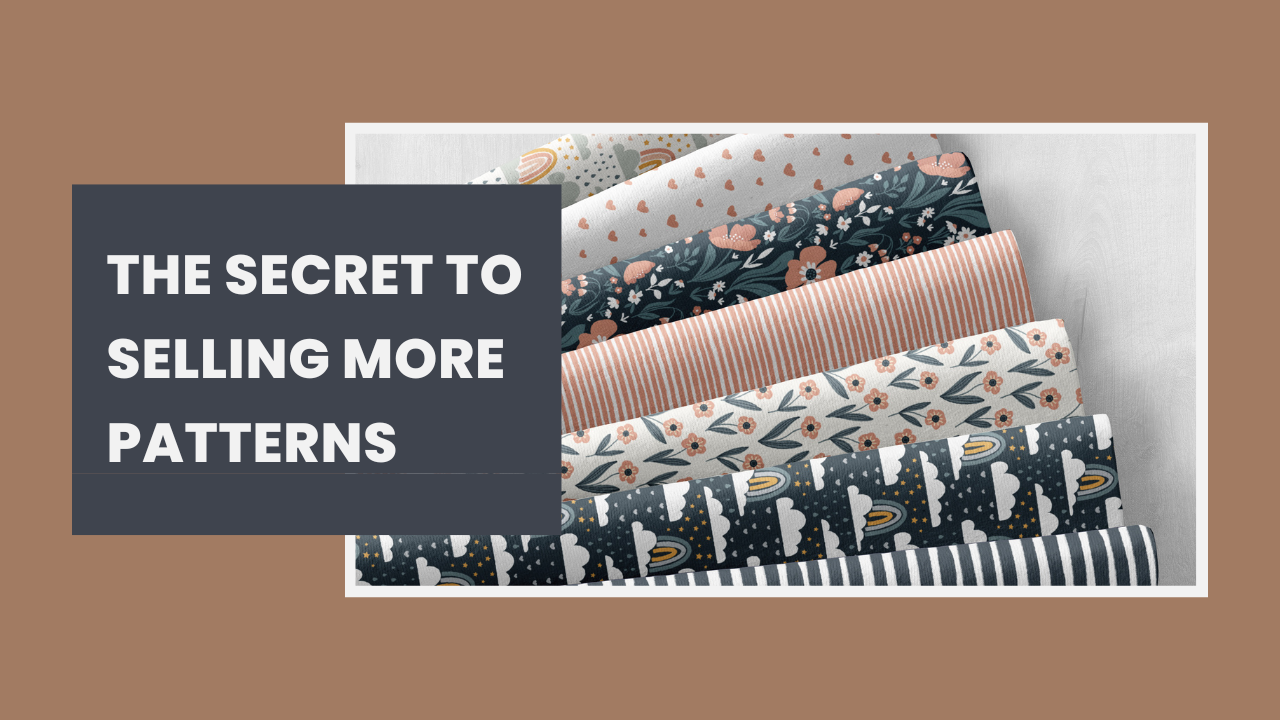
Surface Pattern Success: Discover Your Ideal Customer Avatar
Nov 24, 2025Don’t Design Into the Void
Let me paint you a picture: You've spent hours on your latest design. It's a bold pattern that you've never seen anyone else do. It's unique. It's special. The colors? Perfection. The composition? Stunning. You upload it to your shop with all the excitement of a kid on Christmas morning, and then... nothing. No comments. No likes. Nothing but haunting silence.
Here's the thing: creating stunning patterns is only half the battle. The other half? Actually knowing who you're creating them for. And no, "anyone who appreciates beautiful art" doesn't count as a target audience. Trust me, I learned this the hard way.
When I first started my surface pattern design journey, I was attracting what I thought was a life-changing number of people to my work. High numbers are great, right? Wrong.
I was getting “drive-by” interest, but no sales. It was like displaying my work in a museum – I attracted crowds of people who wanted to appreciate it, study it, maybe even take a photo with it. But nobody walks into the Louvre planning to buy what's on the walls and put it on their spring product line. I had admirers when I needed customers.

That's when I realized I needed to get serious about identifying my Ideal Customer Avatar (ICA) – and everything changed.
What Even Is an ICA? (And Why Should You Care?)
Your ICA is basically your dream customer brought to life through research and a dash of creative visualization. Think of them as a real person with real problems, preferences, and shopping habits. The more detailed your picture of this person, the easier it becomes to create designs they'll actually purchase.
Without a clear ICA, you're essentially throwing spaghetti at the wall and hoping something sticks. When you have an ICA, you're serving up exactly what your customer ordered, plated beautifully.
Step 1: Identify Your Market
This question is KEY: are you designing for licensing clients or individual makers?
Licensing clients are the corporate giants – companies looking for unique, marketable designs to put on everything from bedding to birthday cards. They're the Goliaths of the pattern world, with big budgets and even bigger reach.
Individual makers, on the other hand, are the quilters, sewists, crafters, and small business owners who buy fabric by the yard or patterns for specific projects. They're shopping on Spoonflower at 2 AM, or scrolling Etsy for the perfect print to make their next creation shine.
Here's my two cents: start with the makers.
Why? Because they're easier to reach, more responsive to direct outreach, and honestly? Seeing your first pattern printed on someone's handmade tote bag or quilt gives you a validation boost that's better than any motivational poster. That early success gave me the confidence (and the portfolio proof) I needed to eventually pitch to bigger licensing clients.
I made my first real income from small business owners who needed custom designs. That’s real money from real people who loved my work – and that's pure gold when you're starting out.
Step 2: Get Laser-Focused
Once you know your general market, it's time to get specific.
Ask yourself:
- How old are they? Are you designing for Gen Z crafters obsessed with cottagecore, Boomer quilters who've been perfecting their craft for 30 years?
- What's their income level? Are they splurging on premium fabric from indy designers, or shopping exclusively during sales?
- What's their aesthetic? Bold geometrics? Delicate vintage florals? Maximalist jungle prints? Minimalist Scandinavian vibes?
- Where do they shop? Target? Anthropologie? Small indie boutiques? Online POD platforms?
- What are their pain points? Are they frustrated by busy patterns? Limited color options? Not enough unicorn motifs?
The more granular you get, the easier it becomes to create designs that make your ICA think, "Did someone read my mind? Because this is EXACTLY what I've been looking for!"

Step 3: Ask Questions Like Your Business Depends On It (Because It Does)
Your newsletter and social media aren't just broadcasting channels – they're two-way streets for gathering valuable intel.
Use them strategically:
- Run polls asking about style or color preferences
- Send email surveys about what types of patterns your subscribers want
- Post stories asking "Would you use this for X or Y?"
Every single interaction is a chance to understand your ICA better. The more you learn about what makes them tick, the better you can create designs that truly resonate.
When I started using my Weekly Eduletter: 3,2,1...Let's Design as a two-way conversation instead of a one-way newsletter blast, everything shifted. I wasn't just talking at my audience – I was learning from them. And that still informs design decisions I make.
Step 4: Stay Flexible (Your ICA Might Evolve)
Here's something nobody tells you: your ICA isn't carved in stone.
As you grow as an artist and business owner, your ideal customer might shift too. Maybe you start out designing for hobby sewists and eventually pivot toward licensing for children's products. Maybe your aesthetic evolves from boho florals to mid-century modern geometrics.
That's okay. Actually, it's more than okay – it's normal.
Keep your ear to the ground. Pay attention to which designs get traction and which ones flop. Notice patterns in customer feedback. Adapt.
Now What? Create FOR Them
Here's where the rubber meets the road: once you've identified your ICA, you actually have to design for them.
Not for yourself. Not for other artists. Not for what you think should be popular. For your ICA.
Ask yourself with every design:
- Would my ICA love this?
- Does this solve a problem they have or fulfill a desire?
- Would this fit seamlessly into their life/business/aesthetic?
Don't be afraid to talk directly to them. Through your product descriptions, through your social captions. use language that resonates. Reference their world. Show them you get them.
When you truly understand your ICA and design with them in mind, something magical happens. You stop attracting casual scrollers and start building a community of genuine fans who can't wait to see what you create next.
Want to Master Your ICA Using AI?
If you're thinking, "This sounds great, but where do I even start?" – I've got you.
Understanding your ICA isn't just about demographics. It's about digging into their pain points, desires, shopping habits, and creative needs. And here's a secret: you can fast-track this entire process using ChatGPT.
I've created a FREE 5-day course called Master the ABCs of Your Creative Art Biz that walks you through exactly how to define your ICA, identify their struggles, and position your designs as the perfect solution. Using AI-powered prompts, you'll get crystal-clear on who you're serving and how to reach them.
Because here's the truth: you can be the most talented pattern designer on the planet, but if you're not creating for the right people and getting your work out in front of them, your art will just collect digital dust.
The Bottom Line
Designing without knowing your ICA is like hosting a potluck where everyone brings dessert. Sounds fun in theory, but nobody's leaving satisfied.
Take the time to understand who you're creating for. Get specific. Do the research. Ask the questions. And then – here's the important part – actually create for them.
When you nail your ICA and design with intention, you'll transform from "just another pattern designer" into the go-to artist your ideal customers have been desperately searching for.
Now go figure out who your dream customer actually is. You’ve got this.


